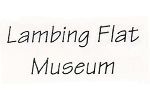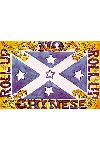Lambing Flat Museum

The museum is currently housed in the former Young Public School, built in 1883. Originally opened in the town library in 1967 by the Young Historical Society, formed in 1958, the museum later moved to larger premises in the old Presbyterian Church building that was unfortunately destroyed to make way for a restaurant. The museum then moved to the Young Public School.
Address:
Community Arts Centre, Campbell Street,, Young, NSW
Tel:
0263822248
Hours:
10am-4pm every day, except Good Friday, Xmas Eve & Day
Admission:
Adult $4.00, Senior $3.50, Concession $3.00, Child (5-11yrs) $1.00
Facilities:
Wheelchair access, guided tours, education programs, brochure, gold panning
Collection:
Collection items total tens of thousands and have various points of interest. Displays include a collection of fashion items dating from 1854, war memorabilia and items from the Old Young Gaol. Also, a number of trades and professions, instruments and phonographs, old armoury items, radios, gramophones, telephone exchanges and telephones, barber chairs and tools, dentistry display, hairdressing displays of early perming equipment (our torture chamber), plus old farm tools, kitchen items and a lot of knick knacks - something to interest everyone.
Subject:
- Historical Society
- Portraits
- Numismatics, Coins and Currency
- Domestic Items
- EducationAndSchools
- Medals and Badges
- Weapons Arms and Armor
- Women
- Agriculture
- Clocks
- Clothing, Fashion, Costume
- Communications
- Horse Drawn Transport
- Mass Media
- Photography
- Printing
- Steam Machinery
- Telecommunications
- Tools
- Aboriginal Artefacts
- Film Sound and Video
- Literature
- Music
Items
Roll Up Banner

Creator:
Tom McCarthy
Description:
The "Roll Up" Banner was carried during the riots of 1861, where European miners on the Lambing Flat goldfields rose up against the Chinese miners and drove them from the diggings. This uprising later led to the introduction of the White Australia Policy.
A brief history: A report that 1500 Chinese had landed in Sydney bound for Burrangong in mid June stirred the Diggers to unrest, and with no troops stationed at Lambing Flat, the miners rang out the goldfield call 'roll up', following which on the last Sunday in June, 1861 occurred the greatest riots which made the hills of Burrangong ring from end to end and the echos to resound throughout Australia. Three thousand rolled up to move the Chinese off the field. A militant mob took the proceedings out of the hands of the leaders. At ten o'clock in the morning miners assembled at "All and Ale" at Tipperary Gully and, headed by a brass band, began the march to the Flat. Two men carried a hand worked banner having a white cross in the centre on a ground of blue surrounded with stars and scrolls reading "NO CHINESE - ROLL UP, ROLL UP". The banner was trimmed with lace and tied with red and green ribbon and has become legendary in the annals of Lambing Flat (Young). On reaching the Flat, the procession made for the Chinese camp. The mob set upon the Chinese, handling them roughly whilst their pigtails were cut off. Their tents, clothing and furniture were set afire and their mining implements destroyed. The procession moved on to Back Creek, five miles farther on, to the Chinese camp, again causing much damage. The "Miner", the Flat's newspaper, estimated the value of property destroyed at 3000 pounds. When all had been destroyed, the band formed up and the procession headed for home. The lace and ribbons are gone, but here is the "flag" painted over 130 years ago and one of the oldest flags in the history of Australia.
A brief history: A report that 1500 Chinese had landed in Sydney bound for Burrangong in mid June stirred the Diggers to unrest, and with no troops stationed at Lambing Flat, the miners rang out the goldfield call 'roll up', following which on the last Sunday in June, 1861 occurred the greatest riots which made the hills of Burrangong ring from end to end and the echos to resound throughout Australia. Three thousand rolled up to move the Chinese off the field. A militant mob took the proceedings out of the hands of the leaders. At ten o'clock in the morning miners assembled at "All and Ale" at Tipperary Gully and, headed by a brass band, began the march to the Flat. Two men carried a hand worked banner having a white cross in the centre on a ground of blue surrounded with stars and scrolls reading "NO CHINESE - ROLL UP, ROLL UP". The banner was trimmed with lace and tied with red and green ribbon and has become legendary in the annals of Lambing Flat (Young). On reaching the Flat, the procession made for the Chinese camp. The mob set upon the Chinese, handling them roughly whilst their pigtails were cut off. Their tents, clothing and furniture were set afire and their mining implements destroyed. The procession moved on to Back Creek, five miles farther on, to the Chinese camp, again causing much damage. The "Miner", the Flat's newspaper, estimated the value of property destroyed at 3000 pounds. When all had been destroyed, the band formed up and the procession headed for home. The lace and ribbons are gone, but here is the "flag" painted over 130 years ago and one of the oldest flags in the history of Australia.
Garment
Wedding Dress
Description:
Silk Frock in a soft shade of brown, worn at a wedding in 1854. The dress belonged to a sister of William Regan (later Mrs. Hollis of Goulburn) and she wore it on the occasion of his marriage to Eliza White, niece of James White, who was the first settler at Burrangong. The dress shows no sign of wear though the cotton fabric to which the skirt is attached is beginning to perish. The tight waisted jacket has ornamental round metal buttons and a skirt tail which gives the popular bustle effect of the mid-nineteenth century. The skirt has three tiers of box pleats stiffened with four bands of pliable wire at the back to give the shape of the bustle. Since 1935 Miss May Regan of Chatswood has had the dress in her possession. It was given to her by Mr. Tom Fleming, grandson of the original owner. Miss Regan, through Mr. and Mrs. John Regan of Barmedman, has passed the dress on to the Young and District Historical Society.
Date:
1854
Item Id Number:
N584
Communications
Telephone and Exchange
Description:
Old telephone exchange and party line phones.
Musical
Radio
Creator:
AWA
Description:
1926 model - 6 valve battery. Super Heterodyne receiver with an intermediate frequency of 80 Kilo Hertz, speaker brown 2000 OHM, horn type.
Machinery
Auto gaslight machine
Creator:
J F Walker, engineering of Germany
Description:
First owner, Boorowa Council for handwound film projector in 1905, used in later years (1930-1955) for pumping water on Tumbleton Sheep Station, also lighting. Only working machine of its type in the world
Date:
1902 to present
Item Id Number:
N584
